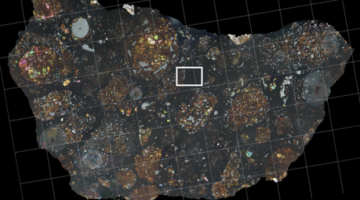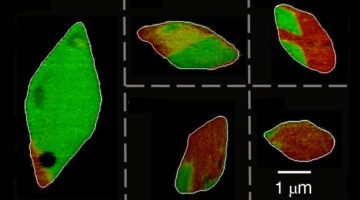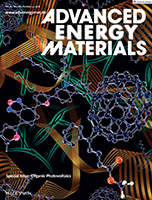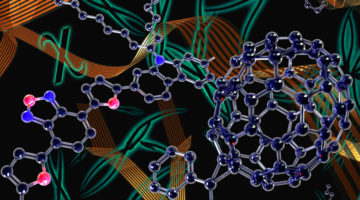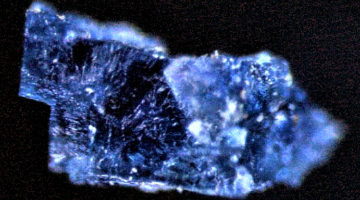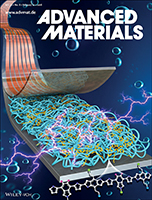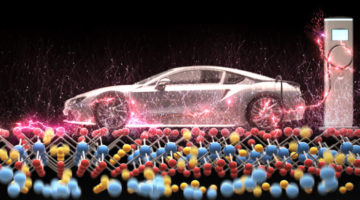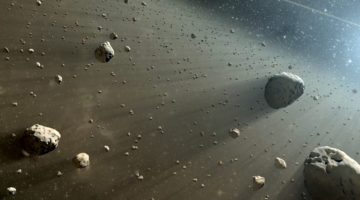Scientists analyzing a tiny carbon-rich pocket inside a meteorite found unexpected chemical signatures. Their findings are the first direct evidence that material from the outer solar system may have traveled inward long before planets formed, providing insight into the early solar system. Read more »
Meteorites Suggest Galvanic Origins for Martian Organic Carbon
Nanoscale analyses of Martian meteorites suggest that organic carbon on Mars may have been formed by electrochemical reactions between briny liquids and volcanic minerals, as might occur in a galvanic cell. The study has major implications for astrobiology and could also shed light on the reactions that led to life on the early Earth. Read more »
Hidden Flow of Lithium Ions Points Way to Better Batteries
Experiments revealed that lithium ions unexpectedly flow along the surfaces of electrode particles, boosting the growth of lithium “hot spots” that shorten battery life. The results correct decades’ worth of assumptions and will help improve battery design, potentially leading to a new generation of lithium-ion batteries. Read more »![]()
Miscibility–Function Relations in Organic Solar Cells: Significance of Optimal Miscibility in Relation to Percolation
In this article, Ye et al. present the determination of liquidus miscibility and its temperature dependence of organic films by scanning transmission x‐ray microscopy and outline an approach to convert liquidus miscibility to an effective Flory‐Huggins interaction parameter χ, which will pave a way to predict morphology and processing strategies of polymer solar cells. Read more »
From Moon Rocks to Space Dust: Berkeley Lab’s Extraterrestrial Research
Berkeley Lab has a well-storied expertise in exploring samples of extraterrestrial origin. This research—which has helped us to understand the makeup and origins of objects within and beyond our solar system—stems from long-standing core capabilities in structural and chemical analyses and measurement at the microscale and nanoscale. Read more »
Rational Optimization of Organic Solar-Cell Materials
Researchers have established a new quantitative model that connects molecular interactions in organic solar-cell materials to device performance. The work suggests a way to quickly identify ideal material mixtures and processing methods, bypassing trial-and-error strategies and minimizing labor-intensive synthesis. Read more »![]()
![]()
Ingredients for Life Revealed in Meteorites
X-ray absorption spectroscopy and other techniques were used to measure the organic chemical components in a pair of meteorites that crashed to Earth in 1998. The study treads new ground in solar system history and asteroid geology, surfacing exciting possibilities for the existence of life elsewhere in Earth’s neighborhood. Read more »![]()
Surpassing 10% Efficiency Benchmark for Nonfullerene Organic Solar Cells by Scalable Coating in Air from Single Nonhalogenated Solvent
Realizing over 10% efficiency in printed organic solar cells via scalable materials and less toxic solvents remains a grand challenge. In this article, Harald Ade and co‐workers report chlorine‐free, in‐air blade‐coating of a new photoactive combination, FTAZ:IT‐M, which is able to yield an efficiency of nearly 11%, despite a high humidity of ≈50%. Read more »
A Path to a Game-Changing Battery Electrode
If you add more lithium to the positive electrode of a lithium-ion battery, it can store much more charge in the same amount of space, theoretically powering an electric car 30 to 50 percent farther between charges. But these lithium-rich cathodes quickly lose voltage, and years of research have not been able to pin down why—until now. Read more »![]()
Ingredients for Life Revealed in Meteorites That Fell to Earth
Two wayward space rocks, which separately crashed to Earth in 1998 after circulating in our solar system’s asteroid belt for billions of years, share something else in common: the ingredients for life. They are the first meteorites found to contain both liquid water and a mix of complex organic compounds such as hydrocarbons and amino acids. Read more »
